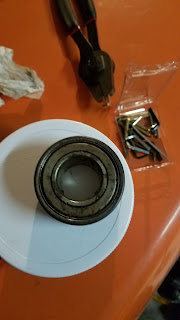"This bay of fertilize would have cost me around $18,000.00 last year. Today we put it in for just over $40,000.00. A tote of Roundup, 275 gallons, last year $4900.00 and today just over $14,000.00. This is just 2 of the inputs for growing a crop. This is not a political statement so do not take it as such. This is real world prices farmers are having to battle." - Owner-operator at Tri-C Farms, Tompkinsville, KY.
I grew up on a farm in Eastern Pennsylvania but I haven't farmed since the 1980s: I claim no expertise in modern farming. But agriculture and associated subjects such as the biology of soil, plant use of soil nutrients, composting, organic and sustained farming, etc. are still interests of mine and I do still read articles about them. Most large farms rely almost solely on chemical fertilizers, herbicides, and pesticides to produce the annual crop. Their soil is nearly dead from high chemical use.These inputs are getting more and more expensive as inflation climbs, the current lack of interest in working continues, and petroleum prices soar.
Amish, Mennonite, and organic farms are not in the same dire situation so it might be a good idea to locate those farms now and see if they have an on-farm stand or operate a Community Supported Agriculture (CSA) farm. (Search for a local CSA at this site: https://www.localharvest.org/csa/ ). These farms produce less per acre but with the use of manures, compost, and natural/mechanical pest and weed controls they are not as affected by inflation and petroleum costs.
Large corporate run farms simply cannot obtain and spread enough manure and compost to support the high yields they must produce to turn a profit. But small food plots can. During the hardships created in Russia during the reign of the Communist Party (USSR days), food was scarce. Central control of agriculture in the world's largest but sparsely populated country did not work very well. To survive, almost every family had a small plot of land outside the city that they intensively gardened to produce fresh fruits and vegetables. With a small plot you can amend the soil with ease and control pests and weeds manually.
You can do the same. I have posted several times about my own gardening and you can go back through the posts here and find those. But today, I'm just going to talk about the wisdom of finding a plot of ground that you can raise some food to help out your pantry. Where? I hear you, sometimes it is hard.
In my own yard I have maintained a 14x40 foot garden for many years.
If you don't have a yard, you'll have to search for alternate locations.
When I was stationed at Fort Polk I had enough room in my fenced in back yard to build an "L-Shaped" raised bed that was four feet wide and twelve feet long on the long side and four feet long on the short side. That gave me a garden of only 64 square feet. But the soil was perfect; made from a mixture of sphagnum moss, course sand, composted manure, and compost from my compost bin. I grew enough food in that small plot, using Square Foot Gardening techniques that I had to give food away.
When I was stationed at Fort Belvoir I rented a 40x60 foot plot from the county for $30 a year. I raised so much there that I actually started selling the excess at work.
In The Netherlands, I got permission from my landlord to pull up pavers from my back patio and created a 6x14 foot garden that provided fresh vegetables year round. Not enough to feed a family but more than enough to supplement what foods I was buying.
It is possible that you can find a landowner that would be willing to let you use a small plot to garden in exchange for work.
Empty store shelves is a more and more common sight and is not going to get any better any time soon. The ongoing labor shortage, the supply chain bottlenecks, bad weather, pandemic-induced panic buying, etc. are not going away. YOU need to establish your own supply chain; that could be foraging, gardening, buying into a CSA program at a local farm, etc. But you need to do something. When food gets scarce, panic buying will empty the shelves and run up the prices.








